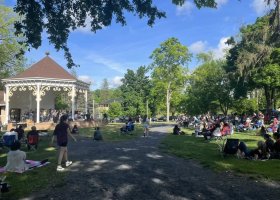
Explore Staunton on Foot: Wharf Historic District
In the 1840s, Staunton grew from a sleepy town to a thriving center of commerce with the construction of the Staunton-Parkersburg Turnpike. The town’s growth accelerated again when the Virginia Central Railroad arrived in 1854. The Wharf Historic District grew up around the train depot to handle merchandise and house passengers. Along with warehouses and hotels, this district also featured saloons, distilleries, liveries, and brothels. Despite a history fraught with the perils of fire, flood, war, and abandonment, significant historic architecture survives. The Historic Staunton Foundation has focused on the area’s restoration since 1989.
Where to Park
Park in the Wharf Parking Lot on Johnson Street or across the street form the lot is the Johnson Street parking garage. You can also park along the street which has a two-hour limit.
Johnson Street
Head right (east) on Johnson Street. The Augusta County Courthouse at 1 E Johnson St. (1901) is located on your left, at the corner of Johnson and Augusta Streets. T.J. Collins designed the Beaux Arts style structure. It is actually the fifth courthouse on this site, dating back to a 1755 log building.
Cross Augusta Street and walk a block to New Street. The buildings on your right are part of the Augusta County District Court System. The historic Stonewall Jackson Hotel (part of the Beverly Historic District Tour rises in front of you.
New Street
Turn right onto New St.
After its first life as a clothing factory, the City renovated 112 S. New St.(1870) in in 1973 as its first mixed-use development project. Bruce A. Elder Antique and Classic Automobiles at 114 S. New St. (1911) was originally a Ford dealership. It now houses two floors of antique cars that are for sale or on display for Friday and Saturday tours. There is even a car elevator! Before you go, call and check their hours of operation.
New Street crosses over Lewis Creek as it emerges from under the city and flows through an attractive greenspace and under a stone footbridge. Stop here to look at the water or snap a selfie. This area, if you can believe it, was once called “A.H.H. Stuart’s Meadow,” and was just that – a meadow with a creek running through it.
Look to your left for trapezoidally shaped 1 Mill St. (1892), once one of the largest flour mills in the Shenandoah Valley. It closed as a mill in 1966, but the basement has housed The Mill Street Grill, which has been dishing up delicious lunch and dinner since 1992.
Augusta Street
At the end of New St., turn right on Middlebrook Ave. The train tracks will be on your left and the American Hotel at 125 S. Augusta St. (1855) will be on your right. The railroad built this luxurious hotel to house railroad travelers, and it escaped burning during the Civil War. Later, during an 1868 stay, President Ulysses S. Grant raised his hat to the serenading Stonewall Brigade Band. Many considered this an early public act of reconciliation after the war. The updated hotel is now one of Staunton’s most popular wedding and reception venues.
Turn right onto Augusta Street. At the turn of the century, this route would have been lively with mule-drawn streetcars transporting passengers from the depot to other parts of town.
Stop to admire 120-124 S. Augusta St. (1876), a building that stands out in a town of brick buildings for its pressed metal upper facade. You’d never know it, but Lewis Creek flows underneath. 119-123 S. Augusta St. (1880) was originally a grocery warehouse but remains to show us how the Victorians sought aesthetic appeal in even their most mundane structures.
Backtrack to Middlebrook Ave.
Middlebrook Avenue
Commerce boomed after the railroad came to Staunton, and the row of brick Wharf Warehouses (1870 – 1910) grew to support it. The area takes its name from the way workers carried food – including the wild game Augusta County was known for – and wholesale goods to and from trains along gangplanks connecting them to the warehouses. Today the buildings support restaurants, retailers, and offices. Originally, the Wharf buildings were much more extensive and spread through the area that is now the Wharf parking lot. Structures here were damaged by a flood in 1896 and destroyed by fire in 1911 and again in 1940.
You won’t be able to miss the Bungalow-style C&O Train Station (1902) across from the warehouses. This station is actually the third on the site. The first was strategically destroyed during the Civil War and the second was demolished by a runaway train in 1890. Some say the site is still haunted by those who perished. Take time to climb up to the cast iron Sears Hill Footbridge and cross it to quiet Woodrow Park on Sears Hill for some of the best views of downtown. Both areas are popular photo sites.
For more train-themed activity, check out the historic train cars in and around the Depot Grille.
Lewis Street
The unusual yellow building you’ll pass on your left at 44 Middlebrook Ave. as you turn onto Lewis Street is the old Fultz Office building, now the tasting room for Ox-Eye Vineyards. Stop in for a tasting or to view the art gallery on the top floor. Next door, 50 Middlebrook Ave was originally the Fultz Warehouse. It is now Wilderness Adventure, where you can purchase gear for your active lifestyle or tour the Story of Virginia Museum, which houses over 200 Virginia artifacts that offer “insight into the personal survival and challenges of real people that developed the great Commonwealth of Virginia.”
Turn right onto Lewis St.
The Klotz building at 202 S. Lewis St. (1929) has been home to Sunspots Studios since 2001. Check out the shop and gallery as well as see live glassblowing in action. Call to verify hours of operation.
The oldest building on your tour can be seen at 118 W. Johnson St. (1854). It features scalloped trim and its original floor plan. You also don’t want to miss taking a look at 109-111 S. Lewis St. (1893) and considering the history of medicine and marketing. This site is where Dr. S.P. Hite brewed patent medicines like “Hite’s Pain Cure.” Hite (who was not actually a doctor) boasted that his magical elixir cured all complaints in man and beast, including paralysis and gangrene.
While many of these stops on the walking tour of the Wharf District do not require you to go inside businesses or other establishments we strongly encourage you to call ahead of time to plan your route to ensure what businesses are open and what protocols they might have in place due to COVID-19.
There are many more sites of historic significance noted on the Historic Staunton Foundation walking tour map. Pick up a walking tour map from the kiosk outside the Visitor Center located at 35 S. New Street and visit some of the other historic districts in downtown Staunton. You can also view and download the walking tour map here.
Newsletter Sign-up
Stay up to date on the latest and greatest happening in Staunton.


